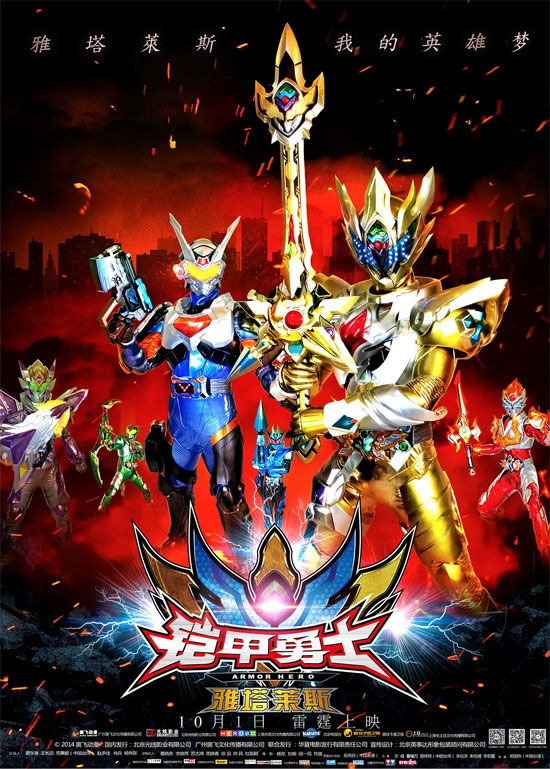Film Name: 铠甲勇士之雅塔莱斯 / Armor Hero Atlas

This “Armor Hero Atlas” is surprisingly high-caliber! From the very start, it delivers nonstop thrills, seamlessly weaving action sequences with emotional arcs. Handsome heroes and beautiful heroines intertwine with grotesque villains and wicked antagonists, elevating the experience far beyond the sluggish, sleep-inducing feel of the earlier “Armor” theatrical releases. It’s utterly riveting—you won’t want to look away for even a second.
I watched a few episodes of the “Armor Hero” series when the first installment debuted, but eventually dropped it as it just wasn’t my cup of tea. The main reason was that Chinese tokusatsu consistently relies on low-budget real-location filming. It completely lacks the scale contrast between monsters and cities found in Japanese tokusatsu, the unique visual impact of gazing up at giants from beneath buildings, or the cathartic satisfaction of seeing structures demolished by monsters. Perhaps after entering the “Kamen” era, Japanese tokusatsu also abandoned that “fake-as-real” aesthetic. Newer tokusatsu films have largely become cosplay-style performance shows, where you’re mostly just watching handsome men and beautiful women strike poses.
So I knew almost nothing about the background of the “Armor Hero Lava” series featured in this film. But this didn’t hinder my understanding of the plot at all; instead, it sparked my interest in watching the Nava series. In the final episode of Navar, Yatales faced the ultimate crisis: a released virus threatening to infect everyone in the city. Here, Yatales’ challenge feels significantly smaller. The film relentlessly builds tension around the virus’s power but never lets it truly spread, culminating in a one-on-one showdown. This feels slightly underwhelming.
Ma Qingshan consistently dedicates himself to providing humanitarian aid to the Oksers. Yet the film refrains from offering a definitive judgment on whether his actions are ultimately justified or worthwhile. This absence of perspective is actually what I found most disappointing—it pales in comparison to the profound lesson Duanmu later learns about the importance of humility in life.
It’s hard to say whether the virus caused the emergence of the Okser, or if it was the host’s unique physiology that allowed it to manifest. We certainly can’t simply equate the Okser with “evil,” but it’s true that this “evil” gene resides within everyone, providing the bacteria with a place to parasitize. In this sense, the enemy doesn’t come from outside—it originates from within us.
Here, we must mention the film’s distinctively characterized Commissioner. He embodies this “evil” gene perfectly—selfishness, hypocrisy, possessiveness, cruelty, and more. While the warriors appear to battle Okser, they are truly fighting the Commissioner. The former conflict is sanctioned by rules, allowing all-out attacks, while the latter is constrained by those very rules, leaving them perpetually at a disadvantage. On one hand, even the most exhilarated warriors in external battles must hold their breath when confronting their own nation’s system. On the other, the inability to resolve internal conflicts inevitably leads to external conflicts serving as scapegoats.
The Director’s execution by Prince Okusher Lambda felt satisfying, yet it also eliminated a more intriguing variable: what would happen if this ultimate embodiment of humanity’s “evil” gene were infected by the virus? He was actually the most suitable host, destined to become Yataress’s final adversary, surpassing even Lambda. Paired with Ma Qingshan’s moral compass, this would have created a profoundly compelling dramatic conflict.
Many scenes in the film carry sharp political satire. One is the scathing portrayal of a politician like the Director, who is solely focused on climbing the ladder. Another is the shocking moment when military and police point their guns at Ma Qingshan’s back as he goes to negotiate—a stark display of the state apparatus being used against a common citizen. These situations are not impossible in real life; they have happened and continue to happen. Behind the fictional story, the film contains many real elements that deserve our deep reflection.
Please specify:Anime Phone Cases » Armor Hero Atlas 2014 Animation Film Review: The real enemy comes from within.